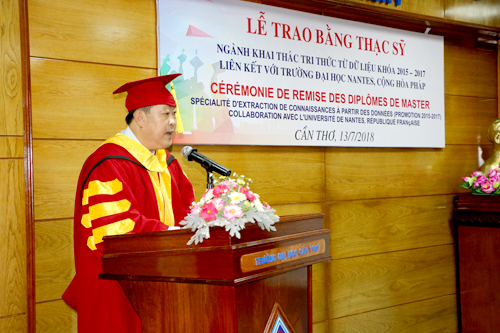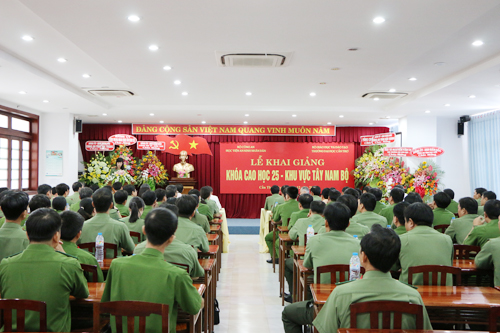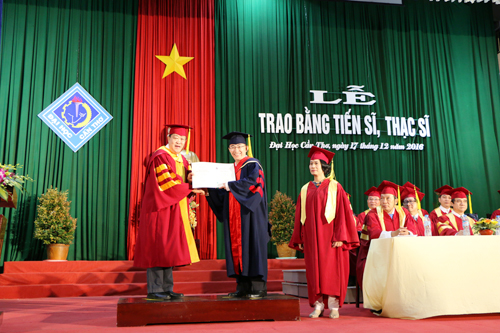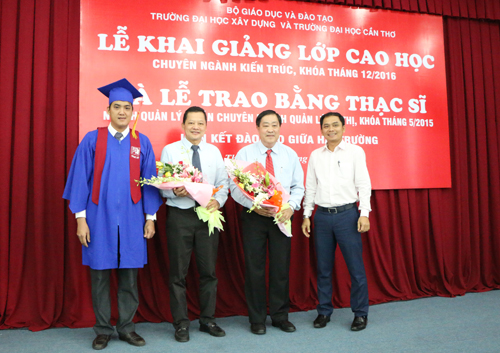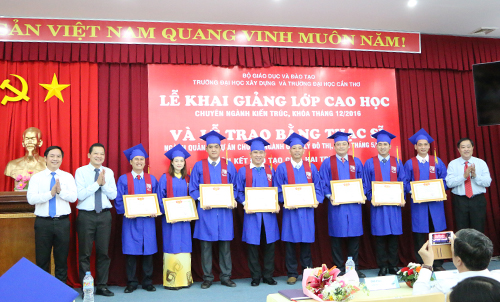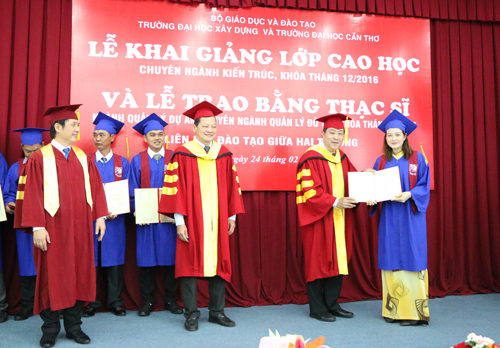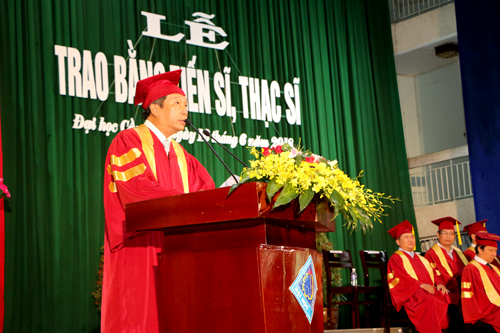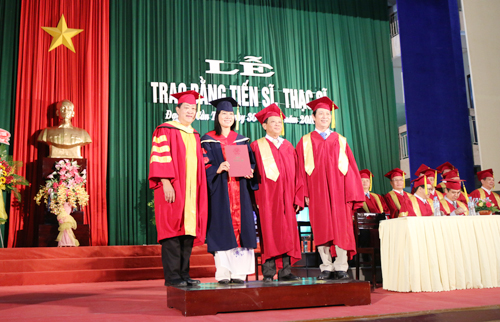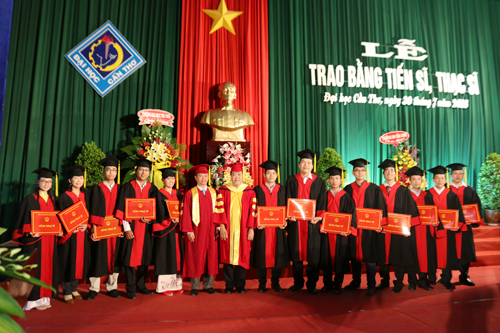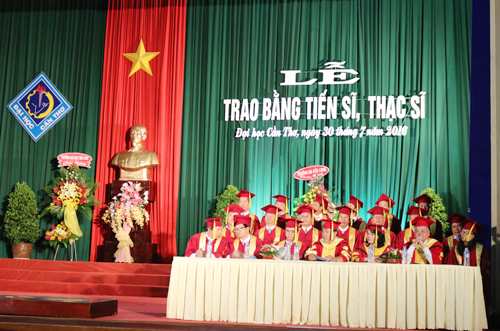Tên đề tài: “Nghiên cứu và định hướng phát triển các mô hình sản xuất nông nghiệp làm cơ sở cho quy hoạch phát triển đô thị thông minh (nghiên cứu cụ thể cho thành phố Thủ Dầu Một - tỉnh Bình Dương)”
Tác giả: Đặng Trung Thành, Khóa: 2019
Chuyên ngành: Quản lý đất đai; Mã số: 9850103. Nhóm ngành: Môi trường và bảo vệ môi trường.
Người hướng dẫn chính: PGS.TS. Phạm Thanh Vũ - Trường Đại học Cần Thơ.
- Tóm tắt nội dung luận án
Trên thế giới, nông nghiệp đô thị thông minh (NNĐTTM) đang được chú ý phát triển trong thời gian gần đây nhằm giải quyết vấn đề nhu cầu lương thực và thực phẩm gia tăng mạnh ở các đô thị. Ở Việt Nam, Chính phủ đã bắt nhịp xu hướng thế giới và xây dựng chiến lược chuyển đổi số để hiện đại hóa đất nước và đặc biệt là phát triển SXNN bứt phá trong tương lai.
Thành phố Thủ Dầu Một (TP.TDM) là đô thị trung tâm hành chính, kinh tế, văn hóa của tỉnh Bình Dương. Để xây dựng, phát triển theo các tiêu chí của ĐTTM thì nhiệm vụ phát triển kinh tế thông minh là rất quan trọng. Trong đó, khu vực kinh tế nông nghiệp được xác định sẽ gặp nhiều khó khăn nhất do những đặc trưng riêng của ngành.
Từ thực tiễn trên, nghiên cứu được thực hiện nhằm mục tiêu: xác định các yếu tố ảnh hưởng đến phát triển các mô hình NNĐT; chọn lọc các mô hình có tiềm năng; xây dựng các mô hình NNĐTTM và đề xuất giải pháp phát triển. Phương pháp thực hiện gồm: thu thập số liệu có liên quan, khảo sát các mô hình sản xuất NNĐT ở TP.TDM; tham vấn ý kiến chuyên gia để xác định các yếu tố ảnh hưởng đến phát triển SXNN đô thị; sử dụng kỹ thuật đánh giá đa mục tiêu để xác định trọng số các yếu tố ảnh hưởng; xây dựng các mô hình sản xuất mẫu và đề xuất giải pháp phát triển các mô hình NNĐTTM.
Kết quả nghiên cứu đã tổng hợp được 26 mô hình SXNN ở 3 khu vực: lõi, ven và ngoại ô đô thị. Đã xác định được 26 yếu tố ảnh hưởng đến phát triển các mô hình nông nghiệp và yếu tố ưu tiên trong phát triển cho 3 khu vực: (1) Lõi đô thị: ưu tiên về công nghệ - kỹ thuật; (2) Ven đô thị: ưu tiên về kinh tế (vốn đầu tư) và (3) Ngoại ô đô thị: ưu tiên về kinh tế (lợi nhuận). Nghiên cứu đã chọn lọc được 21/26 mô hình NNĐT có tiềm năng cho phát triển và thuận lợi áp dụng công nghệ thông minh (CNTM) vào sản xuất. Nghiên cứu đã xây dựng được 6 mô hình SXNNĐT điển hình có áp dụng CNTM: (1) trồng rau thủy canh, (2) trồng rau ăn lá trên đất, (3) trồng cà chua trên giá thể, (4) trồng nấm dược liệu, (5) nuôi gia cầm và (6) nuôi cá cảnh. Kết quả, khi áp dụng CNTM đã mang lại hiệu quả cao hơn so với mô hình canh tác cùng loại không được áp dụng công nghệ thông minh. Nghiên cứu đã đề xuất được 4 nhóm giải pháp chung cho phát triển các mô hình SXNNĐT và các giải pháp cụ thể cho từng khu vực về: CNTM, quỹ đất canh tác, quy mô sản xuất, định mức vốn đầu tư, mô hình sản xuất thích hợp và giải pháp cho tương lai khi các vùng ven đô thị và vùng ngoại ô phát triển lên cao hơn.
- Những đóng góp mới của luận án
Xác định được các yếu tố và mức độ ảnh hưởng trong phát triển các mô hình SXNN đô thị ở vùng lõi, ven và ngoại ô đô thị.
Xác định được thứ tự ưu tiên trong phát triển các mô hình sản xuất NNĐT cho từng khu vực đô thị.
Tổng hợp và xây dựng được các mô hình SXNN áp dụng công nghệ thông minh trong sản xuất làm cơ sở cho quy hoạch phát triển đô thị thông minh.
Xây dựng được giải pháp phát triển các mô hình sản xuất nông nghiệp đô thị thông minh.
- Các ứng dụng/khả năng ứng dụng trong thực tiễn, các vấn đề cần tiếp tục nghiên cứu
Kết quả của luận án là một tài liệu khoa học và thực tiễn cho công tác quy hoạch xây dựng ĐTTM. Đặc biệt là quản lý sử dụng tài nguyên và môi trường cho phát triển nông nghiệp ĐTTM trên địa bàn TP.TDM và các địa bàn tương tự.
Từ 6 mô hình SXNNĐT mẫu có áp dụng các CNTM vào sản xuất đã được xây dựng, giúp cho cơ quan quản lý, khuyến nông, hội nông dân có những mô hình điển hình hiệu quả để phát triển mở rộng sản xuất.
Từ các nhóm giải pháp được đề xuất cho phát triển các mô hình SXNN và các giải pháp cụ thể với từng khu vực đô thị là cơ sở phục vụ cho quy hoạch và xây dựng đô thị thông minh Thủ Dầu Một đến năm 2030, định hướng đến năm 2050.
Cần tiếp tục nghiên cứu xây dựng các mô hình nông nghiệp đô thị thông minh có hiệu quả, đặc sắc, sử dụng tiết kiệm tài nguyên và tái sử dụng các phụ phẩm cho mục tiêu phát triển đô thị thông minh Thủ Dầu Một và các đô thị có điều kiện tương tự.
Thesis title: "Research and Development Orientation of agricultural production models for Smart Urban Development Planning (Case Study of Thu Dau Mot City - Binh Duong province)"
Specialization: Land management Code: 9850103
Full name of Ph.D. Student: Dang Trung Thanh Course: 2019-2022
Supervisor: Assoc. Prof. Dr. Pham Thanh Vu
Academic institution: Can Tho University
- Brief information about the thesis
In the world, intelligent urban agriculture (smart urban farming) has received attention recently to solve the rapidly increasing demand for food and food in urban areas. In Vietnam, the Government has caught up with the world trends and built a digital transformation strategy to modernize the country and significantly develop breakthrough agricultural production in the future.
Thu Dau Mot City (TDMC) is the administrative, economic, and cultural center of Binh Duong province. To build and develop according to an intelligent city's criteria, smart economic development is significant. In particular, the agricultural financial sector is determined to have the most difficulties due to the specific characteristics of the industry.
Stemming from the practice requirements, this study was conducted with the following objectives: determining the factors affecting the development of urban agricultural models, selecting potential models, building innovative urban agriculture models (SUAMs), and proposing development solutions. Implementation methods include collecting relevant data, surveying urban agricultural production models (UAPMs) in TDMC, consulting experts to identify factors affecting the development of urban agricultural production, using multi-objective assessment techniques to determine the weight of influencing factors, building model production models and proposing solutions to develop SUAMs.
The research results have synthesized 26 agricultural production models in 3 areas: core, periphery, and urban suburbs. 26 factors affecting the development of farming models have been identified, and priority factors in effect for three areas: (1) core area of the city: priority on technology - engineering; (2) periphery of the city: economic priority (investment capital) and (3) suburban area of the city: economic priority (profit). The research has selected 21/26 urban agriculture models with the potential for development and favorable application of intelligent technology in production. The study has built six typical UAPMs applying innovative technology: (1) hydroponic vegetable farming, (2) leafy vegetable growing on land, and (3) tomato growing on land. Growing medium, (4) growing medicinal mushrooms, (5) raising poultry, and (6) raising ornamental fish. As a result, applying innovative technology to production brought higher efficiency than the same type of farming model without intelligent technology. The study has proposed four groups of general solutions for the development of UAPMs and specific solutions for each region in terms of innovative technology, arable land fund, production scale, capital norms, appropriate production models, and solutions for the future when suburban and urban areas develop to a higher level.
- New finding of the thesis
Identify factors and levels of influence in the development of UAPMs in the core area of the city, the periphery of the city, and the suburban area of the town.
Determine the order of priority in developing agricultural production models for each urban area.
Synthesize and build agricultural production models applying innovative technology as the basis for intelligent urban development planning.
They are proposing solutions to develop intelligent UAPMs.
- Application/potential application of the study in an actual situation, need for further research.
The result of the thesis is a scientific and practical document for intelligent urban planning—especially the resource use and environment management for SUA development in Thu Dau Mot city and similar areas.
Six agricultural production models with the application of intelligent technologies to production have been built, helping management agencies, agricultural extension agencies, and farmers' associations to have effective models to develop and expand production.
From groups of proposed solutions for developing agricultural production models and specific solutions for each urban area to serve the planning and construction of Thu intelligent Mot Dau city by 2030, towards 2050.
It is necessary to continue to study and build compelling and unique SUA models, save resources, and reuse by-products for the goal of Thu Dau Mot intelligent city development and other projects—urban areas with similar conditions.
- Xem chi tiết nội dung luận án
- Xem thông tin đăng tải tại Website Bộ giáo dục và Đào tạo. (Nhập tên NCS vào ô tìm kiếm)





